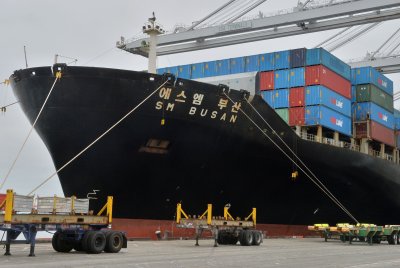
April 12 (UPI) — More than 100 nations in the International Maritime Organization have agreed to fuel standards for ships and fees for carbon emissions offenders, which the Trump administration opposes.
In London on Friday, the United Nations agency members agreed on a draft to be formally adopted in October in an effort to cut down on global carbon emissions.
If adopted, it would go into effect in 2027 for ocean-going vessels over 5,000 gross tonnage, which collectively account for 85% of carbon dioxide emissions from the marine shipping fleet. They did not, however, agree on a levy on carbon dioxide usage, which would net roughly $60 billion a year.
The International Convention for the Prevention of Pollution from Ships has 108 parties, covering 97% of the world’s merchant shipping fleet by tonnage, and already has some mandatory efficiency requirements for ships.
The new draft proposal was agreed upon by the Marine Environment Protection Committee during its four-day session.
IMO has 176 member states and was established in 1948 and met for the first time in January 1959. Most non-member states are landlocked countries, including Afghanistan, Laos, South Sudan and Uzbekistan.
IMO set a goal for shipping to reach net-zero emissions by 2050.
President Donald Trump withdrew from the organization earlier this month, saying the United States would reciprocate against any fees imposed on U.S. ships. The White House and State Department yet commented on the draft proposal.
Major oil-producing states, including Saudi Arabia, United Arab Emirates and Russia, also oppose the measure, as do several small island states who abstained on the final vote. A levy for all carbon dioxide emissions was opposed by those nations as well as Brazil, China and the European Union.
In the agreed-upon plan, there would be a new standard for the volume of emissions per unit of energy used by the ship. Ship owners that do not meet certain emission targets will have to offset their emissions or pay into the IMO net-zero fund, a measure that is forecast to raise about $10 billion.
The fund will be used to reward ships with low emissions, support clean energy research, further the IMO’s greenhouse gas reduction initiatives and support places vulnerable to climate change. The plan is reduce emissions about 8% by 2030. There was a 20% reduction required by the IMO’s climate strategy in 2023.
Ships have been encouraged to use low carbon dioxide fuels and to operate more efficiently, including slowing down.
“The approval of draft amendments to MARPOL Annex VI mandating the IMO net-zero framework represents another significant step in our collective efforts to combat climate change, to modernize shipping and demonstrates that IMO delivers on its commitments, IMO Secretary-General Arsenio Dominguez said.
“Now, it is important to continue working together, engaging in dialogue and listening to one another, if we are to create the conditions for successful adoption.”
According to The Washington Post, some of the opposition to the plan is that “2030 is less than 5 years away … As a matter of scientific, engineering and technical reality it will not be possible to reduce emissions beyond 6% within that time frame for all ships, leading to unnecessary penalization that will result in significant impacts on trade, food and energy security and our beloved sector.”
Environmental groups also would like to see better ways to hit the targets.
“While the targets are a step forward, they will need to be improved if they are to drive the rapid fuel shift that will enable the maritime sector to reach net zero by 2050,” said Jesse Fahnestock, director of decarbonization at the Global Maritime Forum, a nonprofit focused on decarbonization in the maritime shipping industry, told The Washington Post.
Maritime shipping, is responsible for approximately 3% of total greenhouse gas emissions. The maritime shipping industry would rank sixth if compared to countries that emit the largest volume of greenhouse gases, according to the U.S. Energy Department.
In the U.S., there are approximately 40,000 commercial vessels and 360 commercial seaports in addition to 10.5 million motorized recreational boats.
About 12% of the U.S. population lives near seaports, leading to respiratory and cardiovascular disease, dangerous soil and water quality, and poorer health outcomes, according to the agency.
“The U.S. government has committed to ambitious goals for maritime emissions reduction which will require the resources and expertise of the numerous federal agencies working in concert,” the agency said on its website. “The U.S. Department of Energy and its National Laboratory system have important roles to play in this work, especially on research, development, and demonstration.”
It includes low-carbon liquid and gaseous fuels; hybridization and all-electric drive trains; energy efficiency and optimization; and exhaust treatment and carbon capture.
Cruise ships, while a small percentage of the global fleet, contribute significantly to air pollution and carbon emissions, emitting more pollutants. A medium-sized cruise can emit as much particulate matter as a million cars in a day, according to GreenMatch in Britain.
A daily cruise trip averages 700 to 1,000 pounds of carbon emissions, much higher than flying, driving or a traditional “land” vacation, and the sulphur dioxide emissions from a single cruise ship can equal the emissions from 13.1 million cars per day.
The largest cruise ship, Royal Caribbean’s 9,000-guest Icon of the Seas, is 24% more efficient in carbon emissions but with a maximum of 15 cruises a year, it would emit approximately 2.85 million metric tons of carbon dioxide annually, according to GreenMath. This is equivalent to the emissions of about 619,565 average passenger vehicles.